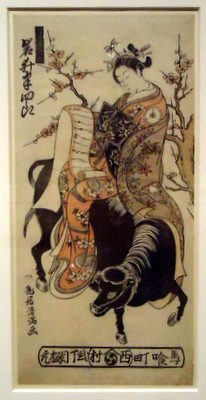Difference between revisions of "Torii Kiyomitsu"
| (One intermediate revision by the same user not shown) | |||
| Line 1: | Line 1: | ||
| − | *''Born: | + | [[File:Kiyomitsu-hanshiro.jpg|right|thumb|320px|A woodblock print by Kiyomitsu, depicting [[Iwai Hanshiro|Iwai Hanshirô]] as a [[courtesan]] seated on an ox]] |
| − | *''Died: | + | *''Born: [[1735]]'' |
| − | *''Japanese'': [[鳥居]] | + | *''Died: [[1785]]'' |
| + | *''Japanese'': [[鳥居]]清満 ''(Torii Kiyomitsu)'' | ||
Torii Kiyomitsu was an ''[[ukiyo-e]]'' artist of the [[Torii school]] who worked chiefly in the period when ''[[benizuri-e]]'' ("rose prints") were at their height, from 1740-1764, before the advent of full-color ''[[nishiki-e]]'' prints. He has been described as the "nominal head of the third generation of the Torii" school and as the "final major figure in the traditional Torii School"<ref>Lane. p89.</ref>. | Torii Kiyomitsu was an ''[[ukiyo-e]]'' artist of the [[Torii school]] who worked chiefly in the period when ''[[benizuri-e]]'' ("rose prints") were at their height, from 1740-1764, before the advent of full-color ''[[nishiki-e]]'' prints. He has been described as the "nominal head of the third generation of the Torii" school and as the "final major figure in the traditional Torii School"<ref>Lane. p89.</ref>. | ||
Latest revision as of 01:17, 25 April 2015
Torii Kiyomitsu was an ukiyo-e artist of the Torii school who worked chiefly in the period when benizuri-e ("rose prints") were at their height, from 1740-1764, before the advent of full-color nishiki-e prints. He has been described as the "nominal head of the third generation of the Torii" school and as the "final major figure in the traditional Torii School"[1].
He was the son of Torii Kiyomasu II, and specialized in images of beautiful young girls, and of kabuki actors.
Some of his works represent the peak of the benizuri-e mode, which, despite the name, often incorporated as many as five different colors. Nevertheless, the techniques involved in producing these colorful images was nevertheless markedly different from the full-color nishiki-e method which would be pioneered by Suzuki Harunobu in 1765.
Kiyomitsu's pupils included Torii Kiyotsune and Kiyonaga.
References
- Lane, Richard. Images from the Floating World. New York: Konecky & Konecky, 1978. p89.
- ↑ Lane. p89.
